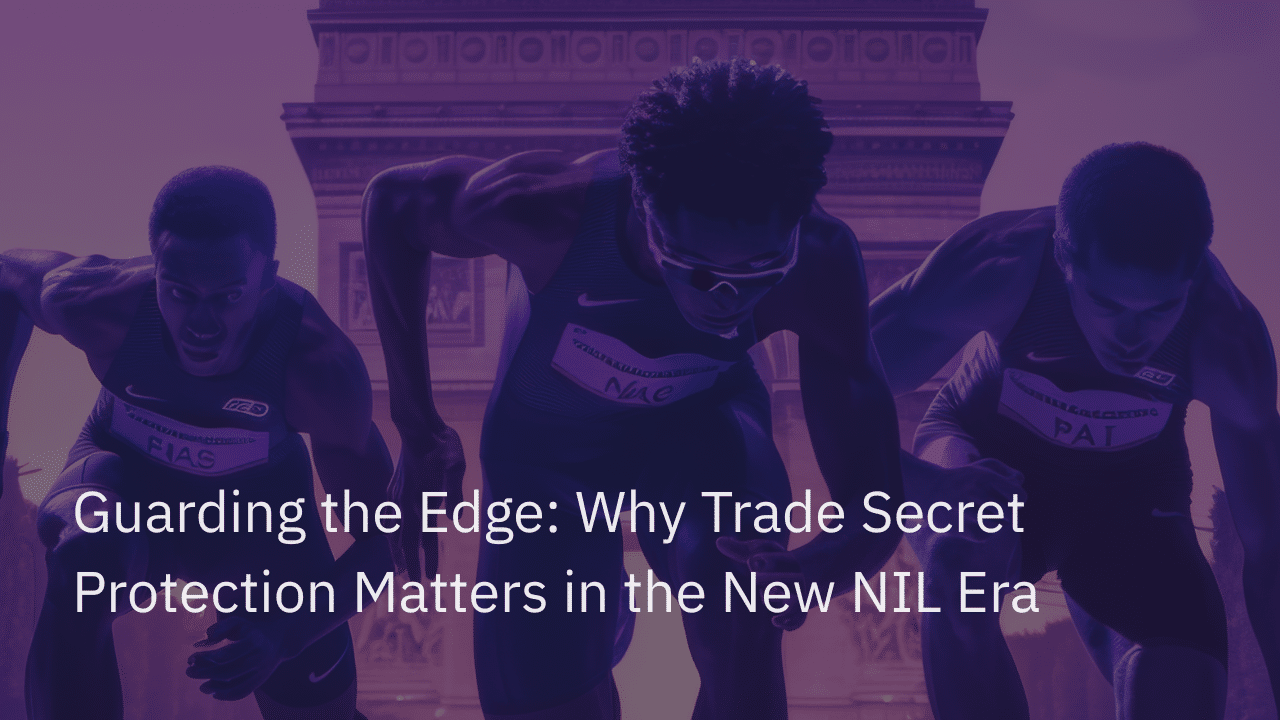Executive Summary
The landscape of college athletics is undergoing a profound transformation. With the recent House v. NCAA settlement and the continued prominence of Name, Image, and Likeness (NIL) deals, athletic departments are no longer just sports programs; they are sophisticated business entities operating in a high-stakes, competitive environment. Critical assets, such as recruiting strategies, intricate NIL contract structures, detailed donor playbooks, and proprietary performance analytics, previously considered internal operational documents, are rapidly evolving into highly valuable, protectable intellectual property. As these programs mature into more complex and competitive enterprises, safeguarding their informational advantage is no longer a mere option but a fundamental strategic imperative.
The New Competitive Landscape and Legal Implications
The House v. NCAA settlement marks a significant turning point, extending beyond a mere legal milestone to fundamentally reshape collegiate sports. The impending reality of college athletes receiving a share of revenue introduces unprecedented business dynamics for every athletic department nationwide. As the financial stakes escalate, so too does the inherent value of proprietary strategies and information. This includes:
Contract structures for revenue sharing: The specific financial models and contractual language developed to distribute revenue among athletes.
NIL negotiation frameworks: Proprietary approaches, valuation methodologies, and preferred terms used in negotiating NIL deals with athletes and external partners.
Recruiting databases and scouting models: Comprehensive data sets on prospective athletes, including analytical models used for evaluation and targeting.
Donor engagement plans: Detailed strategies for cultivating relationships with donors, including specific outreach methods, gift asks, and stewardship protocols.
Performance science and health data protocols: Advanced methodologies for optimizing athlete performance, injury prevention, and recovery, often involving sensitive personal health information.
Under state and federal law, these types of information can be legally classified as trade secrets if they meet specific criteria. Generally, for information to qualify as a trade secret, it must derive independent economic value from not being generally known or readily ascertainable by others who can obtain economic value from its disclosure or use, and it must be subject to reasonable efforts to maintain its secrecy. Without robust protection, these valuable assets are highly vulnerable to misappropriation, whether through inadvertent disclosure, unauthorized access, or outright theft by competitors.
Clemson University’s proactive decision to classify its revenue-sharing contracts as trade secrets underscores the seriousness with which some institutions are approaching this paradigm shift. This strategic move highlights an understanding of the legal avenues available to protect proprietary information. Other athletic departments must swiftly adopt similar protective measures or face the significant risks of competitive disadvantage and legal exposure.
The Risks of Trade Secret Misappropriation
In this evolving environment, the movement of personnel—be it athletes, coaches, administrative staff, consultants, or NIL partners – across different programs presents substantial legal and operational risks.
When an individual departs from a program, they don’t merely take their experience; they often carry with them critical insights into confidential strategies, negotiation tactics, and other proprietary information. This knowledge, if unprotected, could provide a rival institution with an unfair competitive advantage. Without clear policies, comprehensive documentation of what constitutes a trade secret, and robust internal controls, establishing legal ownership over such valuable intellectual capital becomes exceedingly difficult.
The misappropriation of trade secrets is no longer solely a corporate concern. Under the Uniform Trade Secrets Act (UTSA), adopted by most U.S. states, and the federal Defend Trade Secrets Act (DTSA), remedies for trade secret theft can include injunctions to prevent further use or disclosure, damages for actual loss, unjust enrichment, and in some cases, exemplary damages and attorney’s fees. These legal frameworks provide powerful tools for protection, but their effectiveness hinges on the plaintiff’s ability to demonstrate that reasonable measures were taken to protect the secrecy of the information. For college athletics, this means that the proactive identification and protection of trade secrets are now becoming a pressing legal concern that warrants immediate attention.
Proactive Measures for Athletic Departments
To mitigate these risks and legally protect their valuable information, athletic departments should undertake several critical steps:
Identify Their Trade Secrets: The foundational step is to conduct a thorough audit to precisely define and catalog all proprietary information within the department. This includes confidential contracts, unique operational systems, specialized analytical tools, and invaluable institutional knowledge. This identification process is crucial for establishing the legal parameters of what constitutes a “trade secret.”
Educate Staff and Stakeholders on Legal Obligations: Comprehensive education is vital. Every individual with access to sensitive information – from athletic directors and recruiting analysts to NIL consultants and student-athletes themselves – must understand what constitutes a trade secret, its legal significance, and their specific responsibilities in maintaining its confidentiality. This includes training on non-disclosure agreements (NDAs) and confidentiality clauses in contracts.
Implement a Robust Trade Secret Management Process: Effective trade secret protection goes beyond simply locking away files. It necessitates the establishment of an ongoing, systematic process. This includes:
Access Control: Limiting access to sensitive information on a “need-to-know” basis.
Documentation: Meticulously documenting when, how, and by whom sensitive information is accessed, used, and shared.
Valuation: Regularly assessing the economic value of identified trade secrets to underscore their importance.
Incident Response: Developing clear protocols for responding to suspected or actual breaches of confidentiality or misappropriation incidents.
Contractual Protections: Incorporating strong confidentiality, non-disclosure, and intellectual property clauses in all contracts with employees, contractors, athletes, and third-party vendors.
How Tangibly Helps Athletic Departments
Tangibly is specifically designed to empower athletic departments to manage and protect their trade secrets without impeding their dynamic operations.
Education: We provide tailored trade secret literacy programs designed for the unique environment of collegiate sports, educating staff and student-athletes on their legal obligations and best practices.
Identification: We collaborate with departments to systematically map and classify high-value information, ensuring precise identification of assets requiring protection.
Management: Our intuitive platform facilitates the documentation, monitoring, and ongoing management of your trade secrets, treating them as the critical assets they legally are.
Protecting trade secrets, while seemingly complex at first, can be streamlined and effective with intentionality and the right tools.
Take the First Step
In this new era of college sports, every competitive advantage is paramount. Ensure your institution is adequately protecting its most valuable intellectual assets.
Contact Tangibly today to schedule a consultation. We will assist you in developing a robust plan to secure your proprietary information, safeguarding it from potential misappropriation, and ensuring your continued competitive edge.
Raul Sheen is a former collegiate track‑and‑field coach who transitioned into SaaS sales and operations. Since August 2023 he’s been Head of Business Operations at Tangibly, where he drives strategic planning, customer engagement and revenue growth. Say hello on LinkedIn.




















